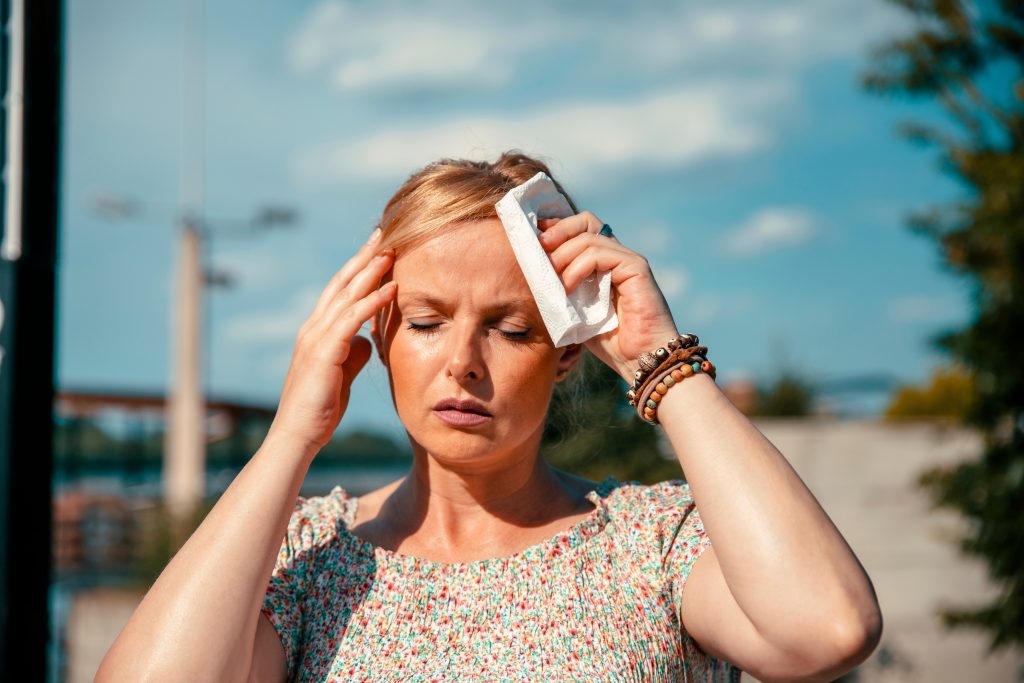August 16, 2022
Can Heat Give You a Headache: Causes, Symptoms, Treatment, and More
Heat headaches are an unfortunate part of the summer season, given that many factors during this time of year can give you heat headaches. Changes in air pressure, humidity, temperature, and dehydration can give you a heat headache.
 Headaches, heat-induced migraine, and tension headaches are all distinct yet interrelated phenomena that can occur. It is also understandable to worry about whether your symptoms are heat exhaustion or COVID-19. Though this article can help you identify potential symptoms, you should always contact a healthcare provider.
Headaches, heat-induced migraine, and tension headaches are all distinct yet interrelated phenomena that can occur. It is also understandable to worry about whether your symptoms are heat exhaustion or COVID-19. Though this article can help you identify potential symptoms, you should always contact a healthcare provider.
Having a headache from heat is no joke. Roughly 20% of American women and 10% of men have severe migraines and headaches at least once every three months. In general, chronic pain affects anywhere from 11% to 40% of Americans and is paired with lost productivity, lower quality of life, and healthcare costs.
Like general chronic pain, headaches are also more prevalent in adult Americans with less income and education and among populations of adult Americans with higher stress. For these groups, a headache from the sun can also intersect with other socioeconomic conditions.
What’s the Difference Between Heat Headaches, Heat-Induced Migraines, Heat Exhaustion, and Tension Headaches?
Most headaches people experience are tension headaches, which also may be called stress headaches or tension type-headaches. Pain may also be present in the neck, eyes, and face; the person experiencing the headache may also feel as if it is spreading to other parts of the body, such as the back and shoulders.
The distinction between migraines and tension headaches is important because migraines have additional neurological symptoms beyond pain, a longer duration, and are both chronic and reoccurring. Symptoms may include but not be limited to nausea and/or vomiting, sensitivity to light, and visual disturbances or auras.
Why Does the Heat Give Me a Headache?
Despite these differences in these conditions, heat can cause headaches and migraines alike. Humidity and changes in weather are both triggers for headaches and migraines. In less scientific terms, changes in moisture and heat can give you a headache.
The mechanisms of how this relates to a headache from the sun are still not entirely known. One hypothesis is that changes in sinus fluid pressure and distribution trigger changes, but this still does not account for a variety of symptoms and potential mechanisms.
Can bright light and heat cause headaches? Yes, too much or changes in light and sound can trigger both headaches and migraines. Stepping outside into a bright and loud summery environment may make enjoying traditional summer festivities difficult.
Dehydration can cause heat headaches and migraines. Sweating keeps you cool through evaporation. Heat in your body is used instead by water molecules on your skin to become gaseous.
 Humidity and heat causes headaches and feels worse because there’s less room in the air for water on your body. Heat and energy are always “looking” for places where this is less of it.
Humidity and heat causes headaches and feels worse because there’s less room in the air for water on your body. Heat and energy are always “looking” for places where this is less of it.
Dehydration happens when the amount of moisture you’re using to keep cool outweighs the amount of water you’re ingesting. It also causes fatigue, light-headedness, and cardiac and circulatory symptoms. This is another way heat can cause headaches.
Dehydration can also lead to heat exhaustion, a precursor to heat stroke. These can be life-threatening conditions, and if you think you are experiencing them, you should seek immediate medical treatment.
Heat exhaustion occurs when the body is not taking in enough water compared to how much is being used, whereas heat stroke begins once the body hits temperatures over 104.0 °F (40.0 °C). Changes in body temperature (in both directions) can cause headaches, dizziness, confusion, and hallucinations.
How Can I Tell if I Have a Heat Headache?
There can be a big difference between what symptoms you need to receive a professional diagnosis regarding headaches and migraines and what symptoms are useful to identify for home treatment. Again, if you suspect you are suffering from heat stroke, dehydration, or other serious medical conditions, you should seek professional help.
The main symptom of both heat headaches and heat-induced migraines include pain in one’s head, eyes, neck, or temples. This may manifest as a throbbing, tightening, or pressing sensation. This is often frequently accompanied by fatigue, photosensitivity, and dehydration. For professional diagnoses of headaches and migraines, other distinctions exist related to pain duration, location, and neurological symptoms.
When Should I Seek Medical Treatment for Heat Headaches?
The following symptoms are signs that your heat headache or migraine may be escalating to heat exhaustion or heat stroke:
- dizziness or disorientation
- severe thirst and/or changes in appetite
- body temperature of over 104.0 °F
- nausea or other gastrointestinal symptoms
- clammy skin and/or loss of skin coloration
How to Get Rid of Heat Headaches
Treating heat headaches before they become more severe not only helps with pain relief but can also be life-saving and prevent costly medical care. While many forms of home remedies and cultural practices exist, the Centers for Disease Control recommend the following three points of care: getting out of direct sunlight, resting, and hydrating.
 Seeking shade or shelter from the sun directly reduces the amount of heat the body is exposed to and makes it easier to recover resources and find relief. Resting and using fewer bodily resources again allows your body to devote all its resources to cool off. Most important, you also need to make sure to increase the amount of water you’re taking into account for lost resources.
Seeking shade or shelter from the sun directly reduces the amount of heat the body is exposed to and makes it easier to recover resources and find relief. Resting and using fewer bodily resources again allows your body to devote all its resources to cool off. Most important, you also need to make sure to increase the amount of water you’re taking into account for lost resources.
Over-the-counter pain relievers such as ibuprofen and acetaminophen can also aid in providing pain relief while the underlying causes are addressed.
Applying a cloth that has been dipped in cold water to the back of the neck can provide relief from the sensation of being hot and make it easier for heat to leave the body (the heat “moves” to the wet cloth).
There is some debate as to whether antioxidants and electrolytes help rehydrate the body or the effect of such components has been exaggerated by various industries. For purposes of medical treatment, water is always the best choice.
Summary
In short, there are many ways heat can cause headaches. The best action is to stay out of the heat and remain hydrated. Many of the mechanisms behind chronic pain are still being researched, but we know for sure that weather and heat can cause headaches and migraines.
As with many conditions, swift treatment and preventative measures go a long way. Dressing in weather-appropriate attire, taking breaks from direct sunlight, and hydrating can all help prevent developing head headaches and migraines.
Finally, if you suspect you are suffering from heat stroke or heat exhaustion, you should always seek out immediate medical attention. Home remedies and treatments cannot replace proper medical care.
Though heat exhaustion or heat stroke are scary to experience, lethal or life-long consequences can be prevented by medical professionals.
DISCLAIMER
The information featured in this site is general in nature. The site provides health information designed to complement your personal health management. It does not provide medical advice or health services and is not meant to replace professional advice or imply coverage of specific clinical services or products. The inclusion of links to other web sites does not imply any endorsement of the material on such websites.